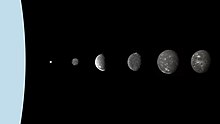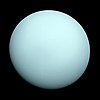MUSE (spacecraft)
| Mission type | Reconnaissance, atmospheric probe |
|---|---|
| Operator | European Space Agency[1] |
| Spacecraft properties | |
| Spacecraft | MUSE |
| Launch mass | 4,219 kg (9,301 lb)[2] |
| Dry mass | 2,073 kg (4,570 lb) |
| Payload mass | Orbiter: 252 kg (556 lb) Probe: 150 kg (330 lb)[3] |
| Dimensions | cylindrical bus 3 m × 1.6 m[3] |
| Power | 436 W Li-ion batteries: 3,376 Wh Generator: four ASRGs |
| Start of mission | |
| Launch date | September 2026 (proposed) November 2029 (if delayed) |
| Rocket | Ariane 6 (proposed) |
| Uranus orbiter | |
| Orbital insertion | 2044 (proposed) 2049 (if delayed) |
| Orbits | 36 |
| Uranus atmospheric probe | |
| Spacecraft component | Entry probe |
| Atmospheric entry | 2044 (proposed) |
MUSE (Mission to Uranus for Science and Exploration[3]) is a European proposal for a dedicated mission to the planet Uranus to study its atmosphere, interior, moons, rings, and magnetosphere.[2][4] It is proposed to be launched with an Ariane 6 in 2026, travel for 16.5 years to reach Uranus in 2044, and would operate until 2050.[4]
The European Space Operations Centre would monitor and control the mission, as well as generate and provide the raw data sets. In 2012, the cost was estimated at €1.8 billion.[2] The mission addresses the themes of the ESA Cosmic Vision 2015-2025.[2] This was designed as an L-Class flagship level mission; however, it is constrained by the need for RTGs.[5] MUSE was also analyzed in the US as an Enhanced New Frontiers class mission in 2014.[3]
Orbiter[]
The orbiter science phase would consist on the Uranus Science Orbit (USO) phase of approximately 2 years in a highly elliptic polar orbit to provide best gravimetry data, during which 36 Uranus orbits are performed.[4]
Subsequently, the orbiter will continue to the Moon Tour (MT) phase, which would last three years. During this phase, the periapsis would be raised, facilitating nine flybys of each of Uranus' five major moons: Miranda, Ariel, Umbriel, Titania, and Oberon.[2][4]
Because of the long distance from the Sun (20 AU on average), the orbiter would not be able to use solar panels, requiring instead four Advanced Stirling Radioisotope Generators (ASRGs) to be developed by ESA.[2][4] The propulsion system for the Earth-Uranus transfer would be chemical: Monomethylhydrazine and Mixed Oxides of Nitrogen (MMH/MON) propellant combination is used.[4]
Atmospheric probe[]
Understanding why Uranus emits such a small amount of heat can only be done in the context of thermodynamic modeling of the atmosphere (density, pressure, and temperature). Therefore, the atmosphere needs to be characterized from both a composition and a thermodynamic point of view.[2] The chemical information to retrieve is the elemental concentrations, especially of disequilibrium species, isotopic ratios and noble gases, in combination with information regarding the distribution of aerosol particles with depth.
Twenty days before entry, the atmospheric probe would separate from the spacecraft and enter the outer atmosphere of Uranus at an altitude of 700 km at 21.8 km/s. It would descend by free fall and perform atmospheric measurements for about 90 minutes down to a maximum of 100 bars (1,500 psi) pressure.[2][4]
Proposed instruments[]
The total mass budget for scientific instruments is 150 kg (330 lb); if all of proposed instruments are selected, they would sum a total payload mass of 108.4 kg (239 lb). In the table below, a green background denotes instruments to go on the entry probe; the rest are for the orbiter.[4]
| Instrument | Description | Dimension, range, resolution | Heritage |
|---|---|---|---|
| VINIRS | Visible and Near Infrared Spectrometer | Electromagnetic radiation: λ: 0.25–5 μm 96 bands (1.8 nm per band) |
Dawn VIR |
| IRS | Thermal Infrared Spectrometer | Electromagnetic radiation: λ: 7.16–16.67 μm 1×10 array of 0.273 mrad squares |
Cassini CIRS |
| UVIS | Ultraviolet Imaging Spectrograph | Electromagnetic radiation: λ: 55.8–190 nm |
Cassini UVIS |
| RPW | Radio and Plasma Wave Instrument | Electromagnetic radiation and plasma waves: 1 Hz–16 MHz (various channels) |
Cassini RPWS |
| MAG | Fluxgate Magnetometer | Magnetic fields: 0–20000 nT Dual 3-axis <1 nT accuracy |
Juno MAG Swarm VFM |
| TELFA | TLF and ELF Antenna | Electromagnetic radiation: Schumann resonances |
C/NOFS VEFI antennas |
| ICI | Ion Composition Instrument | Positive ions: 25 eV–40 keV (dE/E = 0.07) |
Rosetta ICA[clarification needed] |
| EIS | Electron and Ion Sensor | Electrons and ions: 1 eV/e–22 keV/e (dE/E = 0.04) |
Rosetta IES[clarification needed] |
| EPD | Energetic Particle Detector | Particles (free solar wind and those contained in Van Allen radiation belts): Protons: 15 keV–3 MeV Alphas: 25 keV–3 MeV CNO: 60 keV–30 MeV[clarification needed] Electrons: 15 keV–1 MeV |
New Horizons PEPSSI |
| NAC | Narrow Angle Camera | Electromagnetic radiation: 350–1050 nm 6 μrad/pixel |
Cassini ISS |
| WAC | Wide Angle Camera | Electromagnetic radiation: 350–1050 nm 60 μrad/pixel |
Cassini ISS |
| RSE | Radio Science Experiment | Allan variance of radio oscillators: T = 100 s of 1×10−13 Transponders operating at S, X and Ka band |
Cassini RSS |
| MWR | Microwave Radiometer | Electromagnetic radiation: 0.6–22 GHz Gain up to 80 dB Determines temperature profile down to 200 bar atmospheric pressure |
Juno MWR |
| DC | Dust Analyzer | Interplanetary dust particles: 10−15–10−9 kg 1–10 μm (radius) |
Cassini CDA New Horizons SDC |
| DWE | Doppler Wind Experiment | Velocity of wind: Resolution of 1 m/s Determines wind profile down to 20 bar atmospheric pressure |
Huygens DWE |
| AP3 | Atmospheric Physical Properties Package | Temperature, pressure and density profiles: Depth: 0–20 bar |
Huygens HASI |
| GCMS | Gas Chromatograph and Mass Spectrometer | Atoms and compounds: Heavy elements, noble gases, key isotopic ratios (H2/He, D/H, PH3, CO) and |
Huygens GCMS |
| AS & NEP | Aerosol Sampling System and Nephelometer | Atmospheric particle size: 0.2–20 μm (radius) Works at concentrations up to 1 cm³[clarification needed] |
Huygens ACP Galileo GPNE[clarification needed] |
MUSE as new New Frontiers mission[]
In 2014 a paper was released considering MUSE under the constraints of an enhanced New Frontiers mission. This included a cost cap of US$1.5 billion, and one of the big differences was the use of an Atlas V 551 rocket.[3]
See also[]
- Uranus mission proposals
References[]
- ^ Kane, Van (25 September 2013). "Europe Will Select Its Next Major Science Mission in November". The Planetary Society. Retrieved 2016-03-31.
- ^ a b c d e f g h Costa, M.; Bocanegra, T.; Bracken, C.; et al. (June 2012). Mission to the Uranus System: MUSE. Unveiling the evolution and formation of icy giants (PDF). 2012 Post Alpbach Summer School. Madrid, Spain.
- ^ a b c d e Saikia, S. J.; Daubar, I. J.; et al. (2014). A new frontiers mission concept for the exploration of Uranus (PDF). 45th Lunar and Planetary Science Conference.
- ^ a b c d e f g h Bocanegra-Bahamón, Tatiana (2015). "MUSE Mission to the Uranian System: Unveiling the evolution and formation of ice giants" (PDF). Advances in Space Research. 55 (9): 2190–2216. Bibcode:2015AdSpR..55.2190B. doi:10.1016/j.asr.2015.01.037.
- ^ Bocanegra-Bahamón, Tatiana; Bracken, Colm; Costa Sitjà, Marc; Dirkx, Dominic; Gerth, Ingo; Konstantinidis, Kostas; Labrianidis, Christos; Laneuville, Matthieu; Luntzer, Armin (2015-05-01). "MUSE - Mission to the Uranian system: Unveiling the evolution and formation of ice giants". Advances in Space Research. 55 (9): 2190–2216. Bibcode:2015AdSpR..55.2190B. doi:10.1016/j.asr.2015.01.037. ISSN 0273-1177.
- Missions to Uranus
- Orbiters (space probe)
- Proposed space probes
- European Space Agency space probes
- 2026 in spaceflight

